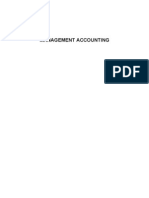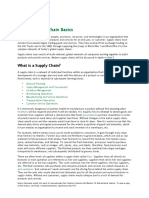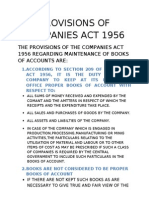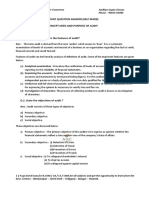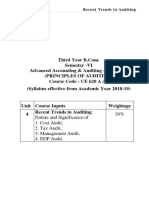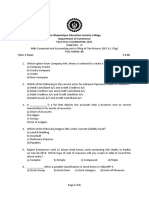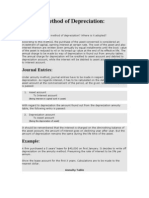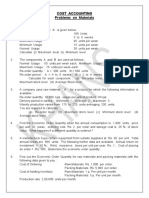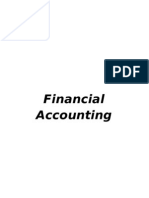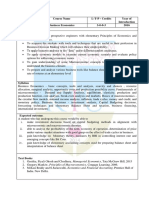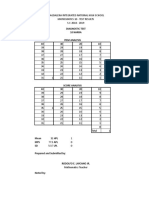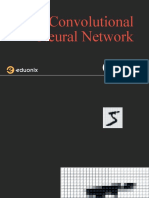Meaning and Definitions of Management Accounting
Meaning and Definitions of Management Accounting
Uploaded by
Hafizullah AnsariCopyright:
Available Formats
Meaning and Definitions of Management Accounting
Meaning and Definitions of Management Accounting
Uploaded by
Hafizullah AnsariCopyright
Available Formats
Share this document
Did you find this document useful?
Is this content inappropriate?
Copyright:
Available Formats
Meaning and Definitions of Management Accounting
Meaning and Definitions of Management Accounting
Uploaded by
Hafizullah AnsariCopyright:
Available Formats
Meaning and Definitions of Management Accounting
Management accounting may be defined as an art and science to provide information to the management so that they can perform their functions efficiently or simultaneously improve their operating efficiency. In the words of J. Batty, Management Accounting is the term used to describe the accounting methods, systems and techniques, which compiled with special knowledge and ability assist management in its task of maximizing profits or minimizing losses. Other important definitions of management accounting are as follows: Any form of accounting which enables a business to be conducted more efficiently. -Institute of Charatered Accountants of England &Wales Management accounting is concerned with accounting information, that is useful to management. -Robert N. Anthony Management Accounting can be defined as the art of presenting to management such figures, whether in terms of money or other units, as will assist management to do its job. -Bostock Accounting which serves management by providing information as to cost or profit associated with some portion of firms total operations is called management accounting. -Shellinglaw Management accounting is an integral part of management concerned with identifying, presenting and interpreting information used for: 1. 2. 3. 4. 5. 6. 7. Formulating strategy, Planning and controlling activities, Decision-taking, Optimizing the use of resources, Disclosure to shareholders and other external to the entity, Disclosure to the employees, and Safe-guarding assets. CIMA London
It is clear from the above definitions that management accounting is concerned with acquiring data from different sources, classifying, analyzing, interpreting and communicating them to the management so that management can perform its various functions more effectively and efficiently. Management accounting is analyzing, interpreting, presenting and communicating the results of financial and cost accounting to the management to enable them in performing various managerial functions. Such as formulation of plans, decision-making, implementation of plan, directing activities of the subordinates and effective controlling of the operations.
Scope of Management Accounting
Scope of management accounting is very vast and includes various aspects of the business activities. Management accounting has its scope in the following fields or systems:
1. Financial accounting :- In this system, business transactions of financial character are recorded in the proper subsidiary book. Posting of these transactions is done in ledger and from this the final accounts are prepared. Final accounts include profit and loss account and balance sheet. Profit and loss account represents the profit/loss earned during the accounting period and the balance sheet represents the financial position of a company as on a particular date. Financial accounting is the foundation from management accounting as it provides the necessary information for prepration of details and reports to be presented to the management. 2. Cost Accounting :- Cost accounting ascertains the cost of producing a particular commodity and rendering of services cost of selling and distribution. It facilitates effective planning regarding commodities, proper decisionmaking and cost control. Some of the important tools of cost accounting are marginal costing, standard costing and budgetary control. 3. Revaluation accounting :- Revaluation accounting ensures that capital is represented at its real value in the accounts and the profit has been calculated keeping this fact in mind. In other words, it assures that the assets are revalued according to the need and its effect has been brought into the accounts. Management accounting helps to ascertain the revalued figures of the assets. 4. Control accounting :- Controlling means to measure the variation, if any, between actual and the standard results and taking corrective measures to remove that variation. Management accounting is the indispensible part of control accounting, budgetary control, inventory control, equality control are some of the important techniques of management accounting for control accounting. 5. Statistical methods :- Management accounting is concerned with presentation of accounting information in the most impressive and understandable manner. It makes use of graphs, charts, index numbers, pictorial presentation and other statistical methods in order to make the information more intelligible. For scientific analysis of financial statement and accounting information various statistical techniques such as mean, standard duriation, cov., correlation, t-test, etc and used in management accounting. 6. Interim reporting :- Interim reporting means preparation of reports on monthly, quarterly and half-yearly basis. These reports include income statement, cash flow statement, funds flow statement, scrap reports etc. 7. Internal audit :- Internal audit means audit of various departments by the internal members of the organization. The techniques of management accounting can be used to judge the efficiency and economy of the organization. Ratio analysis and funds flow analysis are widely used to judge the efficiency of an organization. 8. Taxation :- Tax planning and its management is an essential function of the management. It includes computation of income as per tax laws, filing of returns and payment of tax within stipulated time.
Importance of Management Accounting:
The importance of SMA are as follows:
1.Business Control:
In some instances a healthy bank balance may not indicate a successful company. The cash balance is taken at one point in time, and may in the future be adversely impacted by current trading conditions. Unless the business owner can immediately identify adverse operating trends and take action to correct the situation, it may result in a severe cash flow shortfall later. Management accounts should provide sufficient information to detect positive and adverse trends in sales volumes, operating margins, costs and profit. Importantly this information will be available throughout the trading year and allow for informed business decisions to be taken.
2.Focus on Key Business Areas: a) Sales As part of the management accounts work it would be expected that an analysis of sales, by product is made available. This will allow the business owner to review objective data on product sales trends and to take informed decisions on divestment or investment in different product lines. b) Costs The total business costs are of little value when managing a business. The need to have some cost analysis cannot be underestimated. A business owner/director should know where the company money is being spent and if costs are spiraling out of control. 3.Tax Planning and Dividend Payments: When up to date information is available, a director/owner can plan with greater confidence when transactions need to be made. This approach may be helpful in legitimately reducing the tax liability of the company, and to maximise the potential benefits by payment of dividends as opposed to salary. 4.Demonstrate the Owner is in Control: Knowledge is power. Certainly if the owner can demonstrate to the professional people the business has contact with, that there is a comprehensive understanding of what is happening within the business then respect will be gained and the level of comfort in the business relationship will be heightened. This may be of particular importance in the relationship with the bank manager. 5.Reduced Year End Audit and Accounting Costs: During the process of preparing management accounts many queries will be identified and resolved. If this were not the case, at year end in addition to accounting for twelve month's work, all queries during the period will need to be addressed at the same time. Memories will fade and resolution of issues will take longer and cost more. 6.Detection of Fraud: A regular review of the financial performance of the business will increase the possibility of detecting fraud or other malpractices. Simply the longer time gap between financial reviews will allow wrong doings to remain hidden and more difficult to uncover. Conclusion The preparation of management accounts will provide a valuable tool on which the business owner can manage the business. Informed decisions can be taken based upon objective data and be taken in a timely manner to enable the business to succeed.
Management Control System:
Management Control System is the process of evaluating, monitoring and controlling the various sub-units of the organization so that there is effective and efficient allocation and utilization of resources in achieving the predetermined goals. MCS is a system which gathers and uses information to evaluate the performance of different organizational resources like human, physical, financial and also the organization as a whole considering the organizational strategies. Finally, MCS influences the behavior of organizational resources to implement organizational strategies.
MCS might be formal or informal. The term management control was given of its current connotations by Robert N. Anthony (Otley, 1994). Robert N. Anthony (2007) defined Management Control is the process by which managers influence other members of the organization to implement the organizations strategies. According to Horngren et al. (2005), management control system is an integrated technique for collecting and using information to motivate employee behavior and to evaluate performance. According to Simons (1995), Management Control Systems are the formal, information-based routines and procedures managers use to maintain or alter patterns in organizational activities Chenhall (2003) mentioned that the terms management accounting (MA), management accounting systems (MAS), management control systems (MCS), and organizational controls (OC) are sometimes used interchangeably. In this case, MA refers to a collection of practices such as budgeting or product costing. But MAS refers to the systematic use of MA to achieve some goal and MCS is a broader term that encompasses MAS and also includes other controls such as personal or clan controls. Finally OC is sometimes used to refer to controls built into activities and processes such as statistical quality control, just-in-time management.
Characteristics of Control System: Involvement of people Information about the actual state of the organization is compiled by people. It is compared by people. With the desired state decided by people. For significant difference, a course of action is recommended by people Action taken by people The management decides the desired state or standards against which performance is compared. It decides what the organization plans to achieve in a given time framework which is known as Planning Process. Actual Performance is compared to Planned Performance in control, so planning and controlling are interlinked and are known as P&C systems
Following are the characteristics of effective control system:
1. Accurate. Information on performance must be accurate. Evaluating the accuracy of the information they
receive is one of the most important control tasks that managers face.
2. Timely. Information must be collected, routed, and evaluated quickly if action is to be taken in time to
produce improvements.
3. Objective and Comprehensible. The information in a control system should be understandable and be
seen as objective by the individuals who use it. A difficult-to understand control system will cause unnecessary mistakes and confusion or frustration among employees. 4. Focused on Strategic Control Points. The control system should be focused on those areas where deviations from the standards are most likely to take place or where deviations would lead to the greatest harm. 5. Economically Realistic. The cost of implementing a control system should be less than, or at most equal to, the benefits derived from the control system. 6. Organizational Realistic. The control system has to be compatible with organizational realities and all standards for performance must be realistic. 7. Coordinated with the Organization's Work Flow. Control information needs to be coordinated with the flow of work through the organization for two reasons: (1) each step in the work process may affect the success or failure of the entire operation, (2) the control information must get to all the people who need to receive it. 8. Flexible. Controls must have flexibility built into them so that the organizations can react quickly to overcome adverse changes or to take advantage of new opportunities. 9. Prescriptive and Operational. Control systems ought to indicate, upon the detection of the deviation from standards, what corrective action should be taken. 10. Accepted by Organization Members. For a control system to be accepted by organization members, the controls must be related to meaningful and accepted goals.
Functions: Planning activities of an organization Coordinating activities of an organization
Communication information to different levels of the hierarchical structure Evaluating information and deciding the actions to be taken Influencing people to change their behavior.
Stages of Management Control: The management control process for ongoing operating activities has the following four phases:
(1) Programming
(2) Budgeting (3) Execution (4) Evaluation Control process in the of non operating activities such as project consist of the above phases except that two phases, programming and budgeting are combined into a single activity. Project planning, they are difference in the nature of a project and that are operating activities. A project generally has a single objective and ongoing operating activities have multiple objective. A project comes to an end when the objective is accomplished. An ongoing operating organization intends to operate indefinitely. In some process cases, the completion of project may result into an ongoing operating organization although this may involves complex management control problems. The discussion of the four phases of management control Programming, budget preparation, Execution, Evaluation- are as follows: Programming : Programming is defined as making programs by top/senior management in terms of organization, goals and strategies and deciding the fund and resources needed to accomplish the programs. Programs can be made about development of new products, research and development activities, merger takeover, and other activities that are not related much with existing product lines. In service organizations, such as a hotel Chain management may draw programs for each hotel on each region where the hotels are to be set up. In decentralization, organization, for each segment or central, programming can be done. Programming is a long rang plan, covering period of approximately five future years. The reason is that if programming is made for shorter periods, the result and benefits of programming can not be realized within this period. Some organization like public utilities prepare long rang plans for even a periods of twenty years. Because of relatively long time plan, only rough estimates are possible for revenues, expenses and capital expenditure.
Criticality (1) Its top management is convinced that programming is very important. Otherwise programming is likely to become a staff exercise that has little impact an actual decision making. (2) It is relatively a large and complex. In small, simple organization, an informal understanding of an organization future direction adequate for making decision about resources allocation, which a principles purpose of repairing programme. (3) Considerable uncertainty about the future exists, but organization has the flexibility to adjust to change the circumstances. In relatively stable organization. A program may be unnecessary; the future is sufficiently
like the past so that the program would be only an exercise in extrapolation. If the future is so uncertain that reasonably reliable estimates can not be made, preparation of formal programme is a waste of time. Budgeting : Budgeting is formal financial plan for each year, know as short rang plan, is techniques of expressing revenues, expenses, physical target like production and sales, profit, asset and liabilities usually for periods of one future year. Budget has functions of motivating manager, coordinating activities, communicating to persons within an organization, providing standards for judging actual performance and acting as a control tool. Executing : After the budget preparation, budgeting is used as tool for coordinating the action of individual and department within the organization. In fact within the execution phase, task control is done to ensure the action and performance match with the and desire result. Which performing the managers goals is to achieve budgeted targets, however compliance to budget is not necessary if the plans given in the budget are found as not the best way of achieving the objectives. Adherence to budget is not necessary good, and departure from it is not necessary bad. Evaluation : The management control process ends with evaluation phase in which performance of manager is evaluated. Since it is an after event exercise, the evaluation does effect what has happened, however evaluation phase act like a powerful stimulus as employees know that their performance will be subsequently evaluated. Also on the basis performance evaluation, the future budget and plans are revised. Conclusion: The management control process is behavioral, manifesting itself in interaction among manager and between manager and their sub-ordinates. Because managers differ from another in technical ability, leadership style, interpersonal skill, experience, approach to decision making, affinity for member, and in many other ways, the details of the management control process vary from company to company and among the responsibility centre within company. The difference relate mainly to the way the control system is used. Programming, budgeting, executing and evaluation are not needed in small, relatively stable organization, and it is not worthwhile in organization that cannot make reliable estimates about the future or in organization whose top management does prepare to manage in this fashion.
Key Variables in Management Contol System:
A key variable is a variable the changes in whose value will have significant impact on the performance of the organization.The nature of the key variables vary form organization to organizationdepending upon the nature of the task,technology and environment in which the organization operates.The key variables are the important in explaining the success or failure of the organization.So,they are also reffered to as key success factors,strategic factors and key factors. In order to identify key variables, the input-through put-output model can be used. On the output side the marketing variables become important, on the input side variables related to production processing/maunfacturing become important. Furhter, since the organization operates in a complex socio-economic and political environment it becomes necessary to identify environmental variables. Since the organization uses various kinds of assets for conversion of inputs to output, the variables related to asset management are also important thus, we can generate a
generalised list of key variables. However.every organization will have to identify the relevent key variables for itself. 1.Input Variables: The following are some of the key variables related to input. a.Raw Material Availability: The availability of raw material is an important key variable. Non availability of raw material wil lead to the lower capacity utlization and it may become difficult for the organization to recover fixed costs. A continued problem in the area of procurrement may even lead to closure of the organization. b.Quality: The quality of the raw material is also crucial to the profitability and ultimate quality of the end product. c.Raw Material Costs: Raw material cost needs to be watched closely, particularly when prices tend to fluctuate. Further, if raw material cost constitutes a high peercentage of total cost it becomes necessary to keep a close watch on it. 2.Production Variables: The following are some key variables related to production. a.Capacity: Capacity utilization is a key variable in most situations. It is either affected by marketing variables or procurement variables. It also partly reflects the abilities of the production staff in scheduling and planning as to what to produce, how much to produce and when to produce. b.Losses: Another key variable is the peercentage of spoilage and wastage. In case of process industries, the management closely watches the yield percentage. c.Quality Control: The quality of the product is generally considered an accepted objective of the organizations. The number of customer complains and the quantity of goods returned are indicators of quality. d.Maintenance: The maintenance of equipment is crucial to smooth production and better capacity utilization. A key variable for maintenance could be the number and percentage of productive hours lost due to maintenance. It can be broken into preventive maintenance and break down maintenance. e.Cost: Since costs can have a significant impact on profits, it is essential to control costs. Therefore, appropriate measures indicating the impact of cost should be developed. f.Delivery:
In certain situation, timely delivery is important.Numbero of times a booth gets late delivery is an indication that it may need managerial attention in the case of diary firm. 3.Marketing Variables:
Some of these variables are as follows: a.Order Book Position: In organizations manufacturing for future delivery, the order book position is very important. A large engineering organization in the power sector, manufacturing hydro and thermal turbines, gives special attention to the nature and volume of orders booked. b.Market Share: The market share of a company is used as a key indicator of the companys performance, as it indicates the organizations competitive strength. c.Institutional Sales: If institutional sales is an important component of total sales then orders received from important institutional buyers is an important key variable. If institutional sales are declining, it is a signal of trouble in the marketing area. 4.Asset Management Variables: The management of current and fixed assets is usually given special attention by the management. Therefore,managerial attention needs to be directed towards key variables related to asset management. Some of these variables are discussed below. a.Asset Turnover: The asset turnover is a relationship between total assets and sales volume. A decrease in asset turnover is a signal that attention needs to be drawn to this aspect. b.Working Capital Turnover: The working capital turnover indicates the efficiency of management of working capital. 5.Environmental Variables: The management has to keep its ears and eyes open to changes in environment. It is because of this that quite a few companies look at macro economic variables and other indicators of social and political changes to see the impact of these changes in the environment of their business.
You might also like
- Corporate Accounting QUESTIONSDocument4 pagesCorporate Accounting QUESTIONSsubba1995333333100% (1)
- M1gla NotesDocument76 pagesM1gla NotesChristoff GuntzNo ratings yet
- Accounting Relationship With Other DisciplinesDocument2 pagesAccounting Relationship With Other DisciplinesYogish Patgar100% (3)
- Meaning and Definitions of Management AccountingDocument2 pagesMeaning and Definitions of Management AccountingHafizullah AnsariNo ratings yet
- Management Accounting Notes at Mba BKDocument134 pagesManagement Accounting Notes at Mba BKBabasab Patil (Karrisatte)No ratings yet
- Meaning and Definitions of Management AccountingDocument2 pagesMeaning and Definitions of Management AccountingHafizullah AnsariNo ratings yet
- Chapter 3Document3 pagesChapter 3beenuNo ratings yet
- WEEK 1 Reading MaterialsDocument13 pagesWEEK 1 Reading MaterialsNitishSarafNo ratings yet
- 2 Final Accounts - Sole Proprietor - Format - AdjustmentsDocument14 pages2 Final Accounts - Sole Proprietor - Format - AdjustmentsSudha Agarwal100% (2)
- Provisions of Companies Act 1956 FinalDocument9 pagesProvisions of Companies Act 1956 FinalDiwahar Sunder100% (1)
- Management Accounting Assignment Question I & IIDocument3 pagesManagement Accounting Assignment Question I & IIAbdul LathifNo ratings yet
- Unit - 5 (Special Areas of Audit)Document3 pagesUnit - 5 (Special Areas of Audit)Meghaa KabraNo ratings yet
- Rights and Duties of Company AuditorDocument8 pagesRights and Duties of Company AuditorShaji JkNo ratings yet
- Liabilities of An AuditorDocument4 pagesLiabilities of An AuditorAbhimanyu Seth100% (1)
- Audit Important Question With Answer Chapter 1 To 5Document40 pagesAudit Important Question With Answer Chapter 1 To 5Harsh Jain50% (2)
- Product Mix NotesDocument3 pagesProduct Mix NotesFaidz FuadNo ratings yet
- Discuss The Qualifications and Disqualifications of Auditor of The CompanyDocument9 pagesDiscuss The Qualifications and Disqualifications of Auditor of The CompanyDebabrata DasNo ratings yet
- FMA Financial Accounting Assignments SolutionsDocument58 pagesFMA Financial Accounting Assignments Solutionskrishanptfms100% (1)
- Questions and AnswersDocument3 pagesQuestions and Answershibaaqnaasir390100% (1)
- Unit 4 by Ravi Recent TrendsDocument43 pagesUnit 4 by Ravi Recent TrendsChintan Kalpesh Modi100% (2)
- Tally Erp 9.0 Material Creating Inventory Masters in Tally Erp 9.0Document20 pagesTally Erp 9.0 Material Creating Inventory Masters in Tally Erp 9.0Raghavendra yadav KM100% (1)
- Bill of Exchange - Numerical Questions SolutionsDocument52 pagesBill of Exchange - Numerical Questions SolutionsAnimeshSahaNo ratings yet
- Test Checking Routine CheckingDocument16 pagesTest Checking Routine CheckingApil100% (1)
- Recent Trend in New Issue MarketDocument14 pagesRecent Trend in New Issue MarketAbhi SinhaNo ratings yet
- Human Resource Accounting: Meaning, Definition, Objectives and Limitations! MeaningDocument5 pagesHuman Resource Accounting: Meaning, Definition, Objectives and Limitations! MeaningJahanvi BansalNo ratings yet
- Computerized Accounting Practical RecordDocument21 pagesComputerized Accounting Practical RecordHemamaliniNo ratings yet
- Factors Affect Factors Affecting Working Capitaling Working CapitalDocument24 pagesFactors Affect Factors Affecting Working Capitaling Working Capitalranjita kelageriNo ratings yet
- Unit Iv-Vouching, Verification and ValuationDocument25 pagesUnit Iv-Vouching, Verification and ValuationJABEZ SMITH50% (2)
- Cost Accounting Theory Important Questions..Document2 pagesCost Accounting Theory Important Questions..SAITEJA ANUGULA50% (2)
- Inventory Valuation - Additional Question Set: QuestionsDocument3 pagesInventory Valuation - Additional Question Set: QuestionsDheeraj singhNo ratings yet
- Computerised Accounting and e Filing of Tax Returns SEC 6 1 CHGDocument6 pagesComputerised Accounting and e Filing of Tax Returns SEC 6 1 CHGpratik kmr100% (2)
- Tax Planning in Case of Foreign Collaborations and Joint VentureDocument3 pagesTax Planning in Case of Foreign Collaborations and Joint VentureDr Linda Mary SimonNo ratings yet
- Model Question Financial Accounting - IIDocument3 pagesModel Question Financial Accounting - IIEswari Gk100% (1)
- EX - NO:1 Company Creation Query:: Computerized Accounting PracticalDocument15 pagesEX - NO:1 Company Creation Query:: Computerized Accounting PracticalJinson K JNo ratings yet
- Annuity Method of DepreciationDocument3 pagesAnnuity Method of DepreciationKristin ByrdNo ratings yet
- Investment Accounting ProblemsDocument7 pagesInvestment Accounting Problemspritika mishraNo ratings yet
- Ploughing Back of ProfitsDocument3 pagesPloughing Back of ProfitsSuman Gill100% (1)
- Consolidated QuestionsDocument13 pagesConsolidated QuestionsPoojaSajnani100% (1)
- History of TallyDocument2 pagesHistory of TallyShweta SharmaNo ratings yet
- Social AccountingDocument2 pagesSocial AccountingRajveer Singh SekhonNo ratings yet
- Output CostingDocument39 pagesOutput CostingTarpan MannanNo ratings yet
- Problems On Material CostingDocument9 pagesProblems On Material CostingROHIT TANETINo ratings yet
- Computer Accounting With TallyDocument50 pagesComputer Accounting With Tallymnnappaji0% (1)
- Auditing: Chapter 1: Introduction To AuditingDocument45 pagesAuditing: Chapter 1: Introduction To AuditingMIR AADILNo ratings yet
- Bank Management System Bbanking NotesDocument62 pagesBank Management System Bbanking NotesSarathKumar Nair100% (2)
- ED CycleDocument5 pagesED CycleNayan BhalotiaNo ratings yet
- Auditing and Taxation: Ty Bcom - Auditing and Taxation - MCQ - Question Bank - Compiled by Manoj VoraDocument7 pagesAuditing and Taxation: Ty Bcom - Auditing and Taxation - MCQ - Question Bank - Compiled by Manoj VoraSample Use75% (4)
- Executive SummaryDocument55 pagesExecutive SummaryJasmandeep brar50% (2)
- Balance of Payments Format and NumericalsDocument10 pagesBalance of Payments Format and NumericalsSarthak Gupta100% (2)
- 5th Semester Bcom Auditing Notes Blotia EditDocument214 pages5th Semester Bcom Auditing Notes Blotia EditKnowledge NiwasNo ratings yet
- Clpa Xii New Branches of AuditingDocument7 pagesClpa Xii New Branches of AuditingSARFARAZ AHMADNo ratings yet
- Value Added StatementDocument14 pagesValue Added StatementInigorani33% (3)
- Final Accounts 1. As Per Schedule III of Companies Act 2013, Prepare Financial Statement For Gillette India PVT LTDDocument3 pagesFinal Accounts 1. As Per Schedule III of Companies Act 2013, Prepare Financial Statement For Gillette India PVT LTDermiasNo ratings yet
- Chap 8 - Advanced Issues in ValuationDocument50 pagesChap 8 - Advanced Issues in Valuationrafat.jalladNo ratings yet
- MBA Notes Production and Operation Management 1 PDFDocument130 pagesMBA Notes Production and Operation Management 1 PDFTHIMMAIAH BAYAVANDA CHINNAPPANo ratings yet
- CORPORATE TAX MANAGEMENT Question PaperDocument2 pagesCORPORATE TAX MANAGEMENT Question Paperrahul garhwal100% (1)
- Accounting Standard 6 - DepreciationDocument34 pagesAccounting Standard 6 - DepreciationSarthak Gupta100% (2)
- BA7106-Accounting For Management Question Bank - Edited PDFDocument10 pagesBA7106-Accounting For Management Question Bank - Edited PDFDhivyabharathiNo ratings yet
- Unit 02 Environmental Accounting Notes NET 2019 PDFDocument9 pagesUnit 02 Environmental Accounting Notes NET 2019 PDFsurjeet kumarNo ratings yet
- OTCEI: Concept and Advantages - India - Financial ManagementDocument9 pagesOTCEI: Concept and Advantages - India - Financial Managementjobin josephNo ratings yet
- Management Accounting Mba BKDocument138 pagesManagement Accounting Mba BKBabasab Patil (Karrisatte)100% (1)
- Fa 1Document18 pagesFa 1Rahul KotagiriNo ratings yet
- Galfo Pfe3-Ma1 ModuleDocument36 pagesGalfo Pfe3-Ma1 ModuleMyla BolimaNo ratings yet
- MA - Unit 1Document7 pagesMA - Unit 1Lavin BhawnaniNo ratings yet
- K - Yd Q) DFL S K/Liff-: 2071 L 1Fgf) Bo P DF LJ, W/FGDocument3 pagesK - Yd Q) DFL S K/Liff-: 2071 L 1Fgf) Bo P DF LJ, W/FGHafizullah AnsariNo ratings yet
- K - Yd Q) DFL S K/Liff-: 2071 L 1Fgf) Bo P DF LJ, W/FGDocument3 pagesK - Yd Q) DFL S K/Liff-: 2071 L 1Fgf) Bo P DF LJ, W/FGHafizullah AnsariNo ratings yet
- Saving Deposit Analysis of Nabil Bank Limited: By: Suman Yogi T.U. Regd. No.: Exam Roll No.: 8890037Document1 pageSaving Deposit Analysis of Nabil Bank Limited: By: Suman Yogi T.U. Regd. No.: Exam Roll No.: 8890037Hafizullah AnsariNo ratings yet
- Public AdministrationDocument185 pagesPublic AdministrationAshwani ShrivastavaNo ratings yet
- VankaDocument6 pagesVankaHafizullah AnsariNo ratings yet
- 6.sources of FundsDocument10 pages6.sources of FundsHafizullah AnsariNo ratings yet
- Unity of CommandDocument2 pagesUnity of CommandHafizullah AnsariNo ratings yet
- Test FactorsDocument4 pagesTest FactorsHafizullah AnsariNo ratings yet
- Business Statistics Project On Correlation: Submitted by N.Bavithran BC0140018Document17 pagesBusiness Statistics Project On Correlation: Submitted by N.Bavithran BC0140018BaViNo ratings yet
- HS200 Business Economics PDFDocument3 pagesHS200 Business Economics PDFsethuNo ratings yet
- Understanding The Domain of The Social ScienceDocument14 pagesUnderstanding The Domain of The Social ScienceMaeganh RachoNo ratings yet
- Shell Retail Permit To Work System 5.1 VerDocument7 pagesShell Retail Permit To Work System 5.1 Vermeph imranNo ratings yet
- Geologic Time ScaleDocument2 pagesGeologic Time ScaleAngela Pearl AngelesNo ratings yet
- Test Results 40 Items AutocomputeDocument70 pagesTest Results 40 Items AutocomputeRodolfo Esmejarda Laycano Jr.No ratings yet
- Production Planning and Material Control ManagerDocument3 pagesProduction Planning and Material Control ManagerRajVardhanNo ratings yet
- ContestDocument31 pagesContestTamiru DerejeNo ratings yet
- 2nd Exam G.5 MATHDocument4 pages2nd Exam G.5 MATHmariamagallanes633No ratings yet
- What Is Introduction ?Document14 pagesWhat Is Introduction ?Cindy Aprilia100% (1)
- Stylus Pro 7700 - 7710 - 7900 - 7910 - 9700 - 9710 - 9900 - 9910 (SM)Document440 pagesStylus Pro 7700 - 7710 - 7900 - 7910 - 9700 - 9710 - 9900 - 9910 (SM)Besnik LimaniNo ratings yet
- Introduction To Water TurbidityDocument4 pagesIntroduction To Water TurbidityObaro AjekeNo ratings yet
- Go Cheat Sheet: OperatorsDocument6 pagesGo Cheat Sheet: OperatorsrakeshNo ratings yet
- Apa Example EssayDocument5 pagesApa Example Essayoqzunxbaf100% (2)
- International Project Management: Vishal Kumar ROLL NO.-59 T.Y.BBM (IB) Ness Wadia College of CommerceDocument11 pagesInternational Project Management: Vishal Kumar ROLL NO.-59 T.Y.BBM (IB) Ness Wadia College of CommerceVishal MehtaNo ratings yet
- Marketing Sport Event Tourism: Sport Tourist Behaviors and Destination ProvisionsDocument3 pagesMarketing Sport Event Tourism: Sport Tourist Behaviors and Destination ProvisionsGabriela Ioana IonitaNo ratings yet
- Lab Report CHM 138Document6 pagesLab Report CHM 138syaza qistinaNo ratings yet
- tmp13C TMPDocument283 pagestmp13C TMPFrontiersNo ratings yet
- The Impact of Background Noise On Memory Recall - An Independent Measures Design Study With High School StudentsDocument18 pagesThe Impact of Background Noise On Memory Recall - An Independent Measures Design Study With High School StudentsaliyaabulaisNo ratings yet
- Base Rate PercentageDocument7 pagesBase Rate PercentageChristine AndradeNo ratings yet
- Cipd Reward MNGMTDocument26 pagesCipd Reward MNGMTsalmakda100% (1)
- Gen. Santos Avenue, Bicutan, Taguig CityDocument16 pagesGen. Santos Avenue, Bicutan, Taguig CityArianne B. CabañezNo ratings yet
- MS WmiDocument234 pagesMS WmibubbaoriellyNo ratings yet
- 6sa256 PDFDocument2 pages6sa256 PDFalejandro sanchezNo ratings yet
- Welding Inspection: BS 499 Part 2 Course Reference WIS 5Document11 pagesWelding Inspection: BS 499 Part 2 Course Reference WIS 5rasalkeshav4563100% (1)
- S-ID.1 Interpret Data in Various FormsDocument23 pagesS-ID.1 Interpret Data in Various FormsVinodhkumar Palakode100% (1)
- Convolutional Neural NetworkDocument27 pagesConvolutional Neural Networkmember2 mtriNo ratings yet




